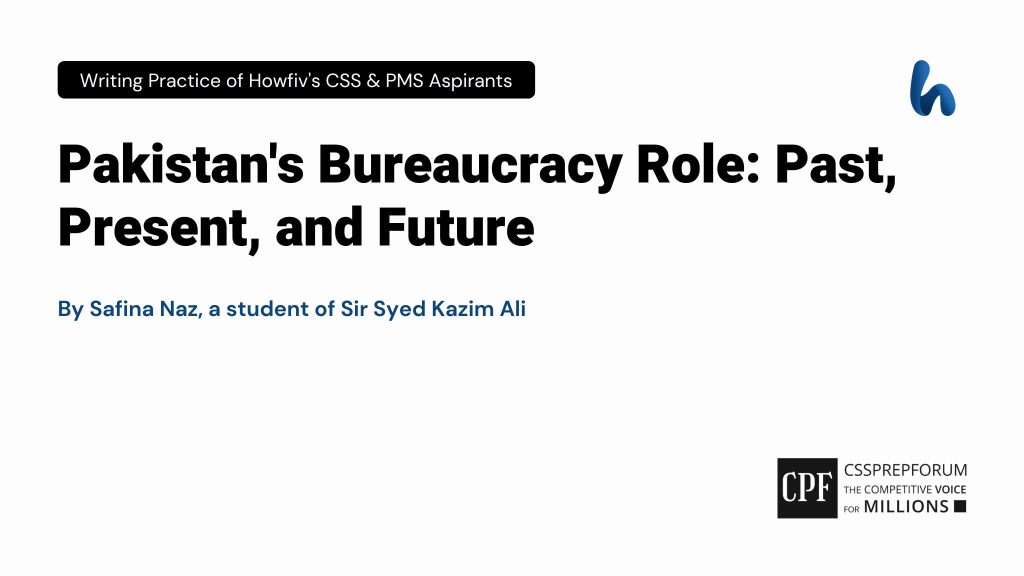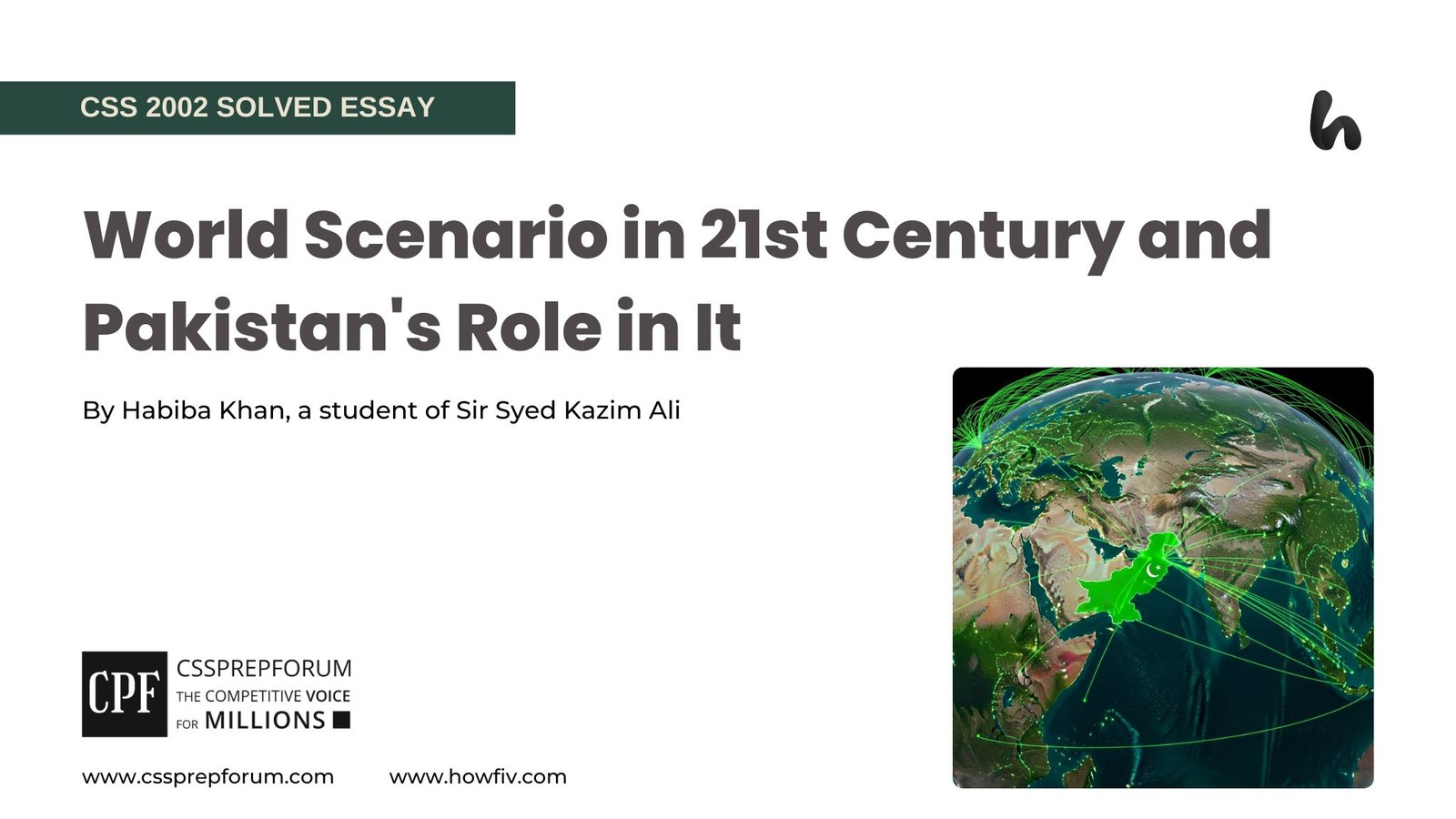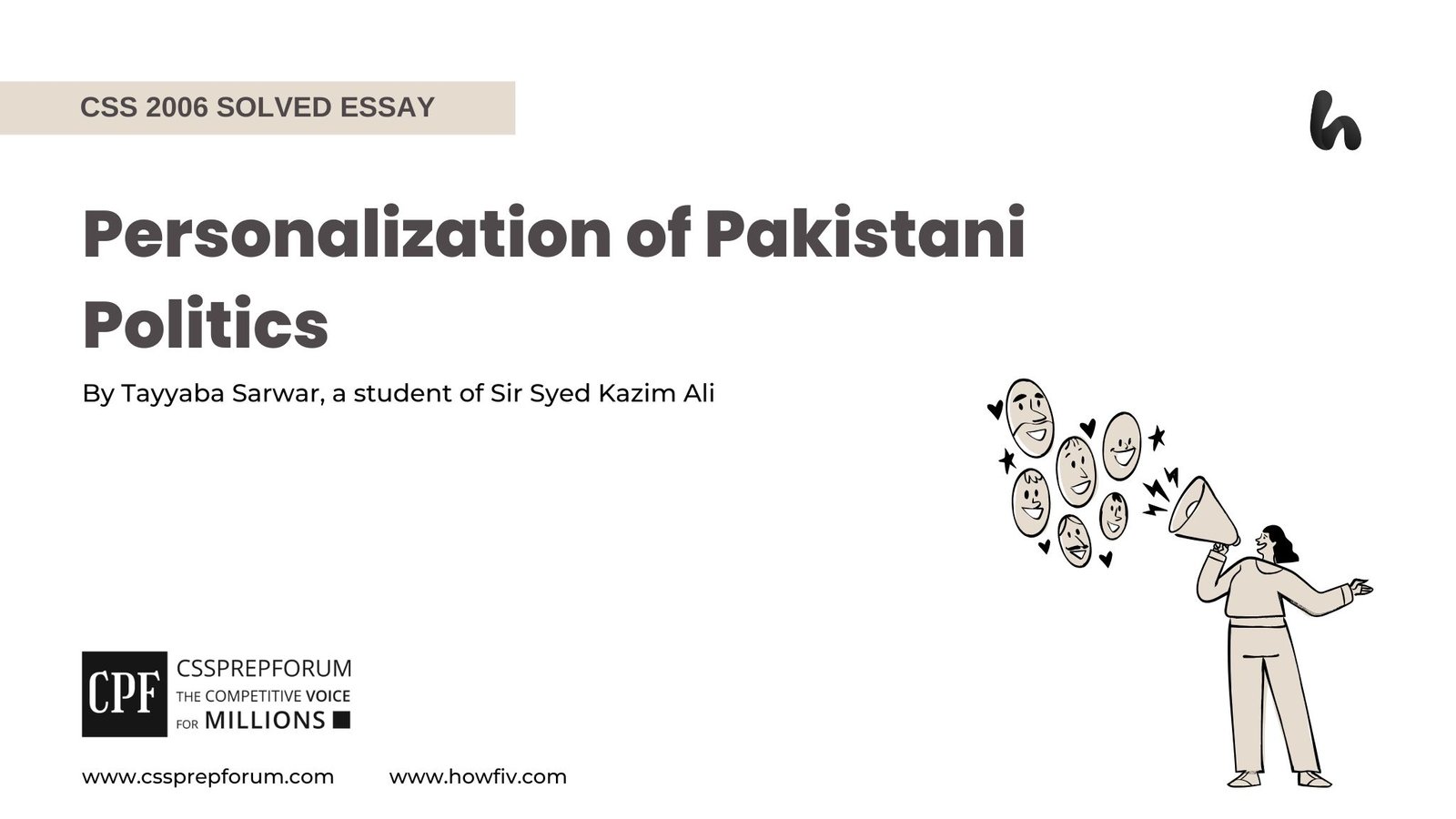Pakistan’s Bureaucracy Role: Past, Present, and Future | Daily Writeup | Opinions
The following article, “Pakistan’s Bureaucracy Role: Past, Present, and Future“, is written by Safina Naz, a student of Sir Syed Kazim Ali. Moreover, the article is written on the same pattern, taught by Sir to his students, scoring the highest marks in compulsory subjects for years. Sir Kazim has uploaded his students’ solved past paper questions so other thousands of aspirants can understand how to crack a topic or question, how to write relevantly, what coherence is, and how to include and connect ideas, opinions, and suggestions to score the maximum.

Outline
1-Introduction
2-Building an understanding of the bureaucratic system
3-Bureaucratic system of Pakistan under the watch
4-How has bureaucracy played its role in the past?
- ✓In the era of Ayub Khan
- ✓ In the era of Zulfiqar Ali Bhutto
- ✓ In the era of Zia-ul-Haq
- ✓ In the era of Pervez Musharraf
- ✓Post Musharraf era
5- What are the persistent challenges that Pakistan’s bureaucracy currently faces?
- ✓Increasing political interference
- Case in point: A tussle between the Chairman of the town municipal corporation (TMC) of Safoora Town, Rashid Khaskheli, and its municipal commissioner, Munawar Hussain Mallah, ended with Mallah’s transfer and the appointment of Imtiaz Hussain Magsi, showing the increasing influence of political parties on bureaucracy.
- ✓Prevailing culture of red-tapism
- Case in point: Due to bureaucratic hurdles, the Rashakai Special Economic Zone (SEC) in Khyber Pakhtunkhwa is facing unnecessary delays in electricity supply to industrial units, which is delaying the country’s developmental projects.
- ✓Mounting corruption in administrative institutions
- Case in point: The opening of an embezzlement case worth 5.8 billion rupees in the M-6 project against Deputy Commissioner (DC) Naushehro Feroze, Tashfeen Alam, shows the corruption of bureaucrats.
- ✓Perpetuating governance crisis
- Case in point: Persistent food crisis and health issues claimed the lives of 200 children during the thar famine, showing the loophole in the management of institutions
6-How can Pakistan’s government change the system and advance towards a better bureaucratic system in the future?
- ✓By Ending elitism in bureaucracy
- ✓By keeping a check on the political victimization of bureaucrats
- ✓By focusing on e-governance
- ✓By bringing change in the intentions of bureaucrats
7-Critical Analysis
8-Conclusion

Bureaucracy, a system of administration, is the strongest pillar that firmly holds the base of a country’s socio-economic and political stability. Having an organizational structure, a bureaucratic system arranges and distributes authority and delegates decision-making power among the different tiers of civil servants, eventually leading to an efficient administrative system of the country. Though various bureaucratic models are followed worldwide, including the Weberian, professional, and regulatory models, developed countries mostly follow professional and regulatory models. However, developing countries rely on the Weberian model for administration. Pakistan, a developing country, has adopted the Weberian model. Looking into the past, multiple events in history, such as the military bureaucracy nexus, the Civil Servant Act of 1973, and the special quota system for military personnel on bureaucratic posts, have shaped the current structure of bureaucracy. Thus, historical events and current developments have tarnished the image of Pakistan’s bureaucracy. The most prominent reason that has negatively impacted bureaucracy is the culture of red-tapism and corruption. Keeping the civilian’s interests aside, bureaucrats work for their interests, rendering the administration ineffective. However, the situation can be rosy if specific steps are taken for better administration. Mentioning them, introducing an e-governance model, including e-registration and e-record keeping, and reducing political interference can help to bottle up the jinn of inefficient bureaucracy. Ultimately, it will help the public servants serve their duties in true letter and spirit. This article briefly describes the role of bureaucracy in Pakistan during the past, in the current time, and in the future.
Heading towards unearthing the concept, bureaucracy is the body of government officials who work to implement policies. According to German Sociologist Max Weber, bureaucracy is a highly structured, formalized, and impersonal organization. It is a hierarchical office working on the principle of planned division of labour among the officials and including the flow of authority from top to bottom, with hierarchy ending with a single bureaucrat at the top. Among the cardinal features of bureaucrats is that they are functionally involved with their positions, accept specific duties of their office, and work for the goal of their specific office. Further, possessing knowledge and specialized skills are the core values for the effective working of bureaucrats, making them work in their total capacity. Thus, the efficient bureaucrats are the backbone of a bureaucratic system.
Moving further into the depth by shedding light on the bureaucracy of Pakistan, being a newly independent state with many issues to deal with, including refugee and economic matters on the top, Pakistan adopted the administrative system having roots in the Government of India Act of 1858. Hence, by evolving from Indian Civil Services (ICS), the bureaucratic system of Pakistan changed into Pakistan Administrative Services (PAS), aimed at appointing officials to take control of the country’s administrative offices. To date, running the bureaucratic operations, government secretariat, and directorate cabinet of Pakistan are the core functions of the administrative team. Further, the bureaucracy of Pakistan consists of 12 directorates, serving the secretariat-related duties to the government of Pakistan. Besides, at the provincial level, the respective Chief Secretaries of Punjab, Sindh, Baluchistan, and Khyber Pakhtunkhwa head provincial bureaucracies. Federal and provincial bureaucracy members are appointed as Civil Superior Services and Provincial Management Services (PMS) through competitive examination. Thus, the bureaucratic system of Pakistan is an amalgam of federal and provincial bureaucracies, each performing a specific task within its ambit by following certain rules and regulations.
Heading towards the historical role of the bureaucracy of Pakistan, initially containing the features of Indian Civil Services (ICS), the Pakistan Administrative System took a head start with only 126 members in the cadre. Along with dealing with the refugee crisis immediately after independence, the Civil Services of Pakistan played dynamic roles, from establishing legal and institutional frameworks to formulating and implementing economic and industrial policies. Additionally, the ruling elite from bureaucracy during the initial years, including Sikander Mirza, Choudary Muhammad Ali, and Choudary Ghulam Muhammad, were. Ghulam Muhammad, a bureaucrat, used his authoritative power to dissolve the constituent assembly and maintain the legacy. Thus, Pakistan’s bureaucracy also played a political role well during the post-independence era.
Further, in the 1960s, the era of Ayub Khan was marked by establishing a military bureaucracy nexus. The martial law imposed by Ayub Khan led to the formation of a nexus, consolidating the power between the military and bureaucracy and avoiding power sharing with political parties. Hassan Askari has penned that situation as “Military Bureaucracy Oligarchy” in his book Military State and Society of Pakistan. Further, discretionary powers in policy-making were given to bureaucrats in Ayub’s era. Hence, during 1st martial law, bureaucracy in liaison with the military created an oligarchic structure, maintaining a hold on the economic and political decisions of the state.
Besides, in the era of Zulfiqar Ali Bhutto, the most prominent advancement was the Civil Servant Act of 1973, an initiative taken to eliminate power control and shift the focus of bureaucracy towards governance. Interestingly, the act replaced class-based categorization with a unified grade system. Furthermore, a common training program was introduced for 13 groups, replacing the elitist titles such as Civil Service of Pakistan. However, this act had downsides, leading to the frequent transfers of civil servants and the compression of salaries. Hence, the era of Zulfiqar was a mixed form of bureaucracy, containing both positives and negatives for the bureaucratic system.
Additionally, a significant event in the bureaucratic history of Pakistan is the militarization of bureaucracy at the hands of General Zia-ul-Haq. He selected a 10 % quota for appointing military personnel in the high ranks of the bureaucracy, ultimately institutionalizing the militarization of bureaucracy. Moreover, recruiting military officials to higher bureaucratic posts brutally led to the depoliticization of the nation. In Zia’s era, policy-making was vested in the hands of the military and its agencies, leaving the country run at the whims of army men. Thus, Zia’s era deprived the bureaucracy of its preeminent policy-making position.
Towards the Musharraf era, limiting the judicial powers of the administrative wing of bureaucracy and introducing representative bureaucracy were the features of the Pervez Musharraf era. According to this system, people were given the right to elect officials at the grassroots level, known as Nazims and Tehsil Nazims. However, despite bringing positive change, the devolution of power weakened the management group. Further, the appointment of military officials to bureaucratic posts continued, maintaining the legacy of the Zia era. During this era, Public Order 2002 was given. Collectively, the devolution of the power plan, as shown in 2001, and the appointment of retired military officials in civilian institutions weakened the bureaucratic setup of the country.
Next, during the post-Musharraf era, the elections of 2008 marked the beginning of a new era of governance in Pakistan. However, the 18th constitutional amendment gave power to provincial departments, initiating a competition between provincial and federal bureaucracy. Federal secretaries for getting more perks and privileges provided a breeding ground for superiority and inferiority debate, creating a dividing line between the federal and provincial bureaucracies. Thus, the era after 2008 further weakened the bureaucracy of Pakistan.
Having discussed bureaucracy in the context of past advancements, it is direly needed to bring the contemporary bureaucracy under light. Currently, certain factors play a paramount role in making bureaucracy inefficient. Mentioning them, political interference has proved to be a significant hitch in inefficient bureaucratic functioning. To keep a firm hold on administrative officials, politicians appoint and transfer bureaucrats to get their work done. In response, bureaucrats get hefty rewards and privileges, tarnishing the essence of bureaucracy and mudding its image nationally. The recent incident in Karachi is a classic example of this. Munawar Hassan Mallah, a municipal commissioner, was transferred from Safoora Town Rashid and Imtiaz Hussain Magsi was appointed in the town due to rivalry between Mallah and the Town Municipal Corporation (TMC) Chairman. Evidently, political interference shaped the transfer and appointment of administrative officers in Safoora town. However, interference prevails throughout the bureaucratic system of Pakistan, not restricted to this town. Thus, the bureaucracy of Pakistan has been the victim of continuous political interference, posing a grave challenge to the efficient functioning of the bureaucracy.
Moreover, the prevailing culture of red tapism has made bureaucracy inefficient, portraying an abysmal picture of administration. Red tapism includes a set of rigid and formal rules designed to produce a barrier to the smooth functioning of an organization, thereby delaying the decision-making and implementation process. For example, due to bureaucratic hurdles, the Rashakai Special Economic Zone (SEC) in Khyber Pakhtunkhwa is facing unnecessary delays in electricity supply to the industrial units, ultimately delaying the country’s developmental projects. The core reason behind this is the false claim of bureaucrats, who have denied giving a license to China Road and Bridge Corporation (CRBC). The excessive hurdles posed in the working mechanism have thus proved to be a significant challenge pertaining to bureaucracy to work in full letter and spirit.
In addition, corruption in bureaucratic institutions has been a recurrent theme in the country since the beginning, leading to Pakistan’s constant slide in the Corruption Perception Index (CPI). Prevailing bribery culture has degraded the morale of bureaucrats to a level that they consider it their apparent right to get perks and privileges by working for the interests of Political leaders. Consequently, corruption has become a new norm in the bureaucracy. An example of corruption is the recent case of embezzlement, where Deputy Commissioner (DC) Naushehro Feroze, Tashfeen Alam, was accused of embezzlement worth 5.8 billion rupees in the M-6 project, stretching from Hyderabad to Sukkur. The case clearly shows massive-scale corruption by state-appointed officials, who work for their vested interests rather than working to maintain rule and order. Thus, another major challenge that prevents bureaucracy from outperforming in its domain is the corrupt mindset of bureaucrats.
Adding to it, a significant problem that bureaucracy deals with is the daunting crisis of bad governance. The governance crisis has left Pakistan at the bottom line in the global ranking as the administrative institutions are plagued with bad governance. The 2014 famine of Tharparker is one such example. Persistent food crises and health issues claimed the lives of 200 children during the thar famine, showing the loophole in the management of institutions. Instead of continuous warnings, public officers neglected the issue, turning the drought into famine. Thus, the negligence of public servants and poor implementation of policies leading to bad governance have hampered the functionality of bureaucracy in Pakistan.
Nonetheless, tables can be turned if Pakistan takes probable measures to bring bureaucracy on track. First, there should be merit-based appointments. Bureaucrats having vulnerable posts must be provided with tenure protection. Take the example of Canada, which appoints and promotes public service officials based on merit, reducing partisan interference. Likewise, in Pakistan, appointing and promoting the officers to higher echelon must be based on merit rather than political affiliation, leading to good bureaucratic governance and improving public service delivery.
Second, there must be an end to the victimization culture in bureaucracy, where every ruling government starts revenge-taking politics by opening Pandora’s box of allegations against bureaucrats. Owing to political pressure, public service officers are forced to work on the whims and wishes of the ruling party, entangling them in a whirlpool of victimization. As a result, to stay at length from the vicious cycle of accusations, bureaucrats stop taking the initiative, fearing that taking the initiative will make them face the music. Thus, the institutional independence of the judiciary, legislative, and executive branches is highly needed, where the judiciary must make independent decisions, irrespective of the party ruling the country. Take the example of the United States, where the separation of power has given independence to the judiciary, a similar independence of the judiciary might help Pakistan grapple with the victimization of bureaucrats.
Third, changing the intention of control in bureaucracy is necessary. The colonial legacy of controlling the country is engraved in the roots of bureaucrats owing to their colonial mindset. Hence, changing it will improve the efficiency of bureaucracy. In this case, India is a glaring instance where state institutions work independently, and politicians are highly empowered and educated. Therefore, it is pertinent to set aside the intention of controlling bureaucracy to bring bureaucracy on track in Pakistan.
Fourth, introducing electronic governance will lead towards the effective functioning of the bureaucracy. E-governance, through the introduction of biometric registration, verification, and payment systems, can help overcome the crisis of bad governance and improve the system. For example, Estonia, a pioneer of e-governance, has introduced e-cabinet meetings, e-tax board, e-voting, blockchain technology and e-portals of road administration. The focus on e-governance has made Estonia sit atop governance reports. Hence, Pakistan can also turn the tide by introducing an e-governance model in the country, eventually incorporating innovative ideas into the system.
In the robust analysis, the bureaucracy of Pakistan has been through tremendous ups and downs throughout history. The bureaucratic system of today is the upshot of all the successive events of history that acted concurrently and shaped the bureaucracy the way it is today. Hence, putting the blame solely on the current administration seems quite unfair. As every bygone government and military ruler has further pushed the bureaucracy at the back gear. So, the form it has adopted today is entirely different from the one Quaid-e-Azam imagined. He advised the public servants through a statement which is penned as, “You should not be influenced by any political pressure, by any political party or individual politician, if you want to raise the prestige and goodness of Pakistan, you must not fall victim to any pressure but do your duty as servants to the people and the state, fearlessly and honestly.” However, in the current times, bureaucrats find themselves in the quagmire of political parties, where the only way out is to work for the vested interests of the politicians, eventually hampering the functioning of administrative institutions. Therefore, there must be some pragmatic approaches to bring bureaucracy on track so that bureaucrats play their role with full potential.
In a nutshell, bureaucracy is a driving force that plays a significant role in the development of a state. Since its independence, Pakistan has been through different bureaucratic eras and has faced multiple challenges. Among them, the most prominent are bureaucratic hurdles, red tapism, administrative functions, and the prevalence of governance crises. These hurdles have reduced the public interest in institutions as the public servants prioritize their interests over the interests of civilians. Nonetheless, a little hope is always there, and Pakistan can bridle up the horse of flawed bureaucracy by taking pragmatic steps. For instance, reducing political victimization and introducing e-governance can significantly make a difference and improve the efficiency of administrative institutions. Therefore, if the bureaucracy of Pakistan plays its due role in true letter and spirit, it will soon be a reality that Pakistan will stand among the world’s prosperous nations.

CSS Solved Past Papers’ Essays
Looking for the last ten years of CSS and PMS Solved Essays and want to know how Sir Kazim’s students write and score the highest marks in the essays’ papers? Then, click on the CSS Solved Essays to start reading them.
CSS Solved Essays
CSS Solved General Science & Ability Past Papers
Want to read the last ten years’ General Science & Ability Solved Past Papers to learn how to attempt them and to score high? Let’s click on the link below to read them all freely. All past papers have been solved by Miss Iqra Ali & Dr Nishat Baloch, Pakistan’s top CSS GSA coach having the highest score of their students. General Science & Ability Solved Past Papers












